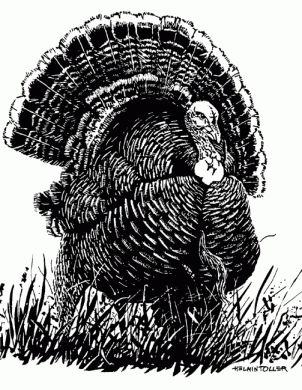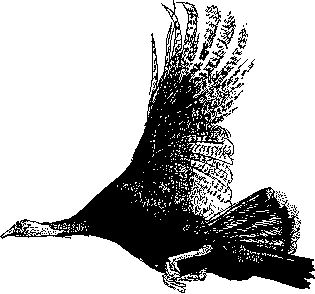Common Birds
Wild Turkey
 The wild turkey is our largest upland game bird. The wild variety is slimmer and has a few color differences than its closely related domestic cousin. They all came from the same original wild stock. The domestic Turkey is thought to be among the most stupid of birds. They have been reported to actually stand out in a sleet storm and die of suffocation when their nostrils plug with ice. If this is true, I feel the blame may lie somewhat in the fact that it was not raised by a worldly and wise mother hen Turkey. We know that when quail and pheasants are pen raised and turned out in nature, their survival is not for long. They are easily preyed on by all of the meat eaters of the wilderness and are easy game for most hunters. Parent birds and animals teach their young how to survive in a world that would have them for lunch.
The wild turkey is our largest upland game bird. The wild variety is slimmer and has a few color differences than its closely related domestic cousin. They all came from the same original wild stock. The domestic Turkey is thought to be among the most stupid of birds. They have been reported to actually stand out in a sleet storm and die of suffocation when their nostrils plug with ice. If this is true, I feel the blame may lie somewhat in the fact that it was not raised by a worldly and wise mother hen Turkey. We know that when quail and pheasants are pen raised and turned out in nature, their survival is not for long. They are easily preyed on by all of the meat eaters of the wilderness and are easy game for most hunters. Parent birds and animals teach their young how to survive in a world that would have them for lunch.
This is especially true of game birds. With their great sense of hearing and sight, they know quickly when danger is near. Truly successful hunters will take trained dogs to search out these various game species. We may feel this is unfair, but it is a fact and the dogs often hunt down wounded game that otherwise might suffer a slow demise.
Adult males stand 48″ with an average weight is 18 pounds. Their breast feathers are black-tipped with iridescent hues of blues and reds, a means of identification. Mature males are called Toms, immature males are called Jakes. Adult females are not as tall standing 36″ and their average weight is 8 pounds. Their breast feathers are buff-tipped, therefore rusty looking. Females are called Hens. The wild turkeys we have today, with the exception of the Eastern Turkey, are similar to the domestic turkey but more slender. Turkeys are found in open woodlands and woodland edges adjacent to open spaces. They are also found in forests where there are scattered openings.
 The flap of skin hanging down the beak is called a Snood. The bumpy skin on the neck are “wattles”, and what looks like a beard on a turkey’s chest is really a bundle of special long, thin feathers. Adult males and even some females have beards but scientists don’t know what, if anything, they’re used for. The spurs on the legs of older birds may be over an inch long curving upward. These are used in fighting, but rarely cause any serious injuries.
The flap of skin hanging down the beak is called a Snood. The bumpy skin on the neck are “wattles”, and what looks like a beard on a turkey’s chest is really a bundle of special long, thin feathers. Adult males and even some females have beards but scientists don’t know what, if anything, they’re used for. The spurs on the legs of older birds may be over an inch long curving upward. These are used in fighting, but rarely cause any serious injuries.
Males will gobble any time of the year, but it heightens in the spring breeding season. At this time, almost any sharp noise will cause them to gobble. A passing airplane, slamming door, passing train or a clap of the hands will set them off. In his breeding plumage the turkey can turn red, white, and blue. His head can turn shades of blue and his wattle can switch quickly from red to white and back again. His snood can grow from 1 inch to 5 inches and the wattle will fill with blood. He will fluff up his colorful feathers and fan out his wide tail attempting to attract hens. Tom turkeys may have a harem of hens consisting of several birds. He will herd them around keeping them in full sight at all times.
Once a hen has mated with the tom she will go off to select a nesting sight. These sites are generally in open areas where she has a 360 degree view to detect any predators. Often she will scratch out a nest in a divot or depression in the ground lining it with leaves and feathers. She will lay a clutch of 10 to 12 buff-colored eggs, lightly spotted with brown and black. When the clutch is complete she will incubate them for an average of 28 days. After the young chicks have hatched the female will continue to brood them for several weeks until they can fly short distances and are able to get off the ground to roost in low tree branches. The female turkey teaches her young the basics of survival, and natural instincts do the rest.
Adult flocks of turkeys will roost together in the highest branches of a tree. It is almost comical to see as many as a dozen of these large birds in the tree tops. Younger turkeys begin resting in the lower braches of a tree when they are four weeks old. They are still growing their feathers so at night snuggle under their mother’s wings, tail, and against her body to keep warm. If they do not keep dry and warm they could perish. Roosting in trees provides them a safe haven from predators, with the possible exception of a Great Horned Owl. If you have wild turkeys on your property or in your yard it is best to keep them as wild as possible. That will benefit them during the hunting season.
Turkeys have excellent flying ability for short distances. They can lift off like a helicopter and once airborne fly forward at speeds up to 55 MPH. But since transporting that much weight in the air takes a lot of energy turkeys run more often than they fly. In short sprints they can reach speeds of 25 MPH, faster than an Olympic runner.
In the winter months turkeys will spend their time in separate flocks. One flock will consist of all toms, the other hens. They work together making certain at least one bird is acting as a lookout to protect the flock from any approaching danger. They will signal to the others if a predator is seen lurking. Turkeys are a fairly common sight anymore often sharing space with humans. But years of hunting may have imprinted a danger in them as they seem to become more elusive when the season opens.
Fun Turkey Facts
• Mature turkeys have 3,500 or so feathers. The Apache Indians considered the turkey timid and wouldn’t eat it or use its feathers on their arrows.
• Turkeys originated in North and Central America, and evidence indicates that they have been around for over 10 million years.
• In Mexico, the turkey was considered a sacrificial bird.
• Only male turkeys (toms) gobble. Females (hens) make a clicking noise. The gobble is a seasonal call during the spring and fall. Hens are attracted for mating when a tom gobbles. Wild toms love to gobble when they hear loud sounds or settle in for the night.
• During the day turkeys forage for acorns, seeds, insects and berries.
• Domestic turkeys cannot fly.
